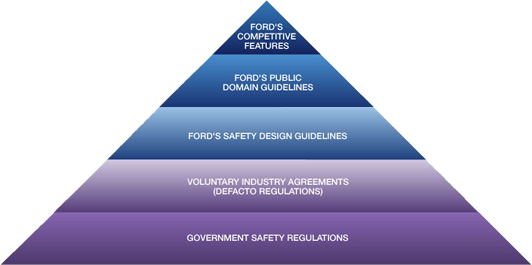Toolbox
How We Manage Vehicle Safety
Here at Ford, our objective is to design and manufacture vehicles that achieve high levels of vehicle safety for a wide range of people over the broad spectrum of real-world conditions. Real-world safety data, driver behavior, research, regulatory requirements and voluntary agreements provide much of the input into our safety processes, including our Safety Design Guidelines (SDGs) and Public Domain Guidelines (PDGs), see graphic below. The SDGs are Ford's stringent internal engineering design targets that exceed regulatory requirements and define many additional requirements that are not regulated. The PDGs are Ford guidelines that focus specifically on helping to ensure that our vehicles earn top marks in relevant public domain assessments.
Both SDGs and PDGs are managed on a global basis and address the local needs of individual regions and markets. Awareness of road safety is rapidly increasing in many emerging markets. In 2009, Ford added Australasian-specific SDGs and PDGs to address this issue – raising the bar for vehicle performance in this market beyond regulatory requirements.

Government-run New Car Assessment Programs (NCAPs) are an increasingly important tool to improve consumer awareness in emerging markets such as China, but their relevance in developed markets is still also very strong. This is likely to remain the case, as both the National Highway Traffic Safety Administration (NHTSA) NCAP and EuroNCAP ratings systems are being significantly altered. As such, fewer vehicles (of all makes) will receive top ratings. Ford is working hard to meet this challenge. We have taken active roles working with NHTSA and EuroNCAP to help ensure that the respective rating schemes will be appropriate and will deliver additional real-world benefit.
Changes to the NCAP system were slated to apply to 2010 model year vehicles, but NHTSA delayed implementation and will now first apply the tougher requirements to 2011 model year vehicles. Ford is continuing to work with NHTSA to address several remaining concerns about the new NCAP test requirements before they are implemented. EuroNCAP's more-stringent requirements went into effect in 2009. However, EuroNCAP does not test all vehicles annually, so no Ford vehicles have yet been assessed under the new system.
Internally, Ford utilizes engineering analyses, extensive computer modeling and crash and sled testing to evaluate the performance of vehicles and individual components. These rigorous evaluations help to confirm that our vehicles meet or exceed regulatory requirements and our even more stringent internal guidelines. Our state-of-the-art crash-test facilities include the Safety Innovation Laboratory in Dearborn, Michigan, and the extensive crash-test facilities in Merkenich, Germany, and Dunton, England.
There has been increased attention recently regarding vehicle manufacturers' processes to investigate customer issues as they relate to potential vehicle safety defects, as well as the role of NHTSA. Ford has a proactive internal system that quickly identifies, evaluates and resolves issues as they relate to potential vehicle safety defects. In addition, when a competitor has a recall, we conduct a review to determine whether we share any of the same vendors, designs or parts. Ford has a very open and transparent process, and we work closely with the NHTSA when they contact Ford regarding customer concerns.
There has also been increased attention recently regarding vehicle electrical systems and the potential for electromagnetic interference (EMI) to affect vehicle performance. We design, engineer and rigorously test our vehicles for the wide range of environments in which they operate, including the potential effects of EMI. Our electronic safety system controls are designed to continuously monitor performance of key vehicle functions, detect issues if they arise and engage back-up functions in the unlikely event they occur.
Global Technical Regulations
The automotive industry is highly regulated, and two systems of vehicle regulation predominate globally: the United Nations Economic Commission for Europe Regulations and the U.S. Federal Motor Vehicle Safety Standards. To meet the relevant regulations of each market in which it sells, manufacturers must modify their vehicle designs and features. This is a particular challenge for Ford, given our increased focus on producing vehicles with the same platforms globally. It can increase vehicle complexity and cost, sometimes without documented, incremental real-world safety benefit.
With the aim of harmonizing world vehicle regulations, 31 countries are working together to develop Global Technical Regulations (GTRs). Ford Motor Company actively participates in the GTR development process.
Thus far, 10 GTRs have been developed. Progress has been slow due to the difficulty of reconciling varied national requirements and the historical differences of existing regulations. Despite these challenges, Ford continues to believe that harmonization has the potential to significantly reduce global complexity while maintaining high levels of vehicle safety, security and environmental performance, and we plan to support harmonization efforts.
Haddon Safety Matrix
Vehicle safety is the product of complex interactions among the driver, the vehicle and the driving environment. We use the Haddon Safety Matrix (developed by William Haddon, a former NHTSA administrator and IIHS president) to take a holistic view of the factors that affect vehicle safety.
The Haddon Matrix looks at injuries in terms of causal and contributing factors, including human behavior, vehicle safety and the driving environment. Each factor is then considered in the pre-crash, crash and post-crash phases. In the pre-crash phase, the focus is to help avoid the crash. In the crash and post-crash phases, the primary objective is to help reduce the risk of injury to occupants during and after a collision. Another goal is to minimize the amount of time that elapses between the crash and when help arrives.
Human Behavior |
Vehicle Safety |
Environment |
|
|---|---|---|---|
Pre-Crash(accident avoidance) |
|
|
|
Crash(occupant protection) |
|
|
|
Post-Crash(injury mitigation) |
|
|
|
Examples of Ford Actions |
|
|
|